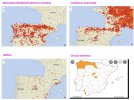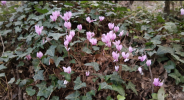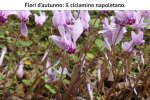The photo of some flowers I saw on my camino was taken in October 2016 between Lacommande and Oloron. I had previously seen similar flowers in Spain -- fields of them giving the whole field a pink blush. I asked what they were called in Villalcázar de Sirga, and the barman said they were called "merendinas". Google tell me that this word means 'snacks', so I think that my Spanish was not good enough to ask the question or perhaps to understand the answer. They are like crocuses, and, perhaps, that's what they are, but I would like confirmation, please, from any gardening experts on the forum. They fascinate me because the flowers come out of the ground with no leaves. I am aware that some flowers have local names as well as official names. For instance, the rock-rose is 'jara' in Spanish but they are called 'estepas' near Ponferrada. [I was told it the opposite way round, but my dictionary has 'jara', but not 'estepa' for a flower.] So the barman could have been right for what they call them around Villalcázar de Sirga.




















